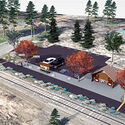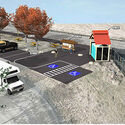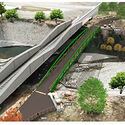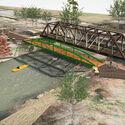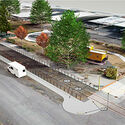100 attend Trail Design webinar
Trail opponents protest Zoom format
April 29, 2021
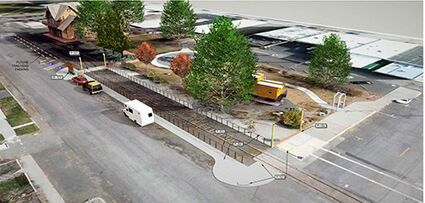
-Submitted photo
The Dayton trailhead would be at the Historic Dayton Depot and Caboose Park, with some parking and already existing access to restroom facilities and within walking distance to most of Dayton's attractions.
DAYTON–The Port of Columbia held a much-anticipated Touchet Valley Trail (TVT) Public Information Webinar, presenting the 30% design by Anderson•Perry & Associates on April 26. The 9.7-mile, 10-foot-wide paved multi-use trail spanning from Waitsburg to Dayton is projected to cost $10.38 million.
As the Webinar prepared to begin via ZOOM, opponents of the trail gathered outside the Port office in a peaceful protest of the meeting being held by Zoom. One participant, Columbia County resident Jude Strode, said those opposed to the trail have valid concerns that are not being addressed satisfactorily. Holding the meeting by Zoom is not acceptable to the group because it's heavily moderated with limited public input. Instead of attending, the group chose to protest the meeting format insisting on future in-person meetings. "People are not getting the facts, but what the Port wants people to think," said Strode.
"It feels good to finally be doing something," commented Kraig Horlacher, who was among the group eliciting support from traffic passing by the Port's Industrial Park.
Trail opponent Paula Murdock met with Port Commissioner Sean Milligan and asked about the decision to hold the meeting by Zoom despite the most recent state guidelines allowing for up to 50% capacity for group meetings. Milligan reportedly told her that some attendees are not comfortable attending in person, and the fairgrounds venue which was considered, has poor internet so holding an in-person and Zoom meeting there may have suffered from an unreliable connection.
The Port's official statement indicated it was holding the meeting by Zoom "in order to comply with state laws, pandemic proclamations, and guidance from health professionals while at the same time providing the best information for citizens to see and hear." Also in the statement, it said the meeting will be recorded and posted on the website for future viewing and comments and questions will be logged and addressed also on the website.
At highest count, 100 attendees were present for the meeting including community members, Port Commissioners, Port staff, Trail Steering Committee members and presenters. One notable attendee was Senator Perry Dozier, R-16, Waitsburg.
Port Executive Director Jennie Dickinson claims that, over the last year, a process was in place to research questions and concerns, investigate trail layout, maintenance cost for the purpose of presenting the results along with mapping and a panel made up of those with trails in their communities to help address issues.
"Over the last year or so, a great deal of time has been spent researching questions and concerns from the public," said Dickinson. "Monday night's meeting was designed to share that information, and to have panelists experienced with actual trails on hand to answer some of these questions. Materials showing the location of the trail, showing research results on questions and concerns from the public, and preliminary maintenance ideas and costs are posted on our website for anyone to view anytime."
The TVT concept began in 2015 when Brad McMasters was the Economic Development Director. He attended meetings for the Blue Mountain Region Trails (BMRT) which were later attended by Dickinson. According to BMRT Plan, "In the December, 2015, annual update of the Comprehensive Economic Development Strategies (CEDS) for Columbia County, county officials and meeting attendees ranked a "recreational path between Dayton and Waitsburg" among the top three priority strategies."
The Port website expands on this to say, "A trail between Dayton and Waitsburg was chosen as the top priority in the regional planning effort. Public workshops continued to show strong interest in the idea, so the project was added to the Cooperative Parks Master Plan and the Port's Comprehensive Plan. The Port received a technical assistance grant from the National Park Service for concept planning, and a WSDOT grant for design and engineering. A steering committee made up of regional stakeholders meets monthly to support design of the project and make recommendations to the Port of Columbia Board of Commissioners."
Dickinson said during the presentation that 90% of the project can be funded by grants, but admitted the funding for the remaining 10% is a question. She added it usually gets covered under construction costs. She emphasized that no new taxes for the project are proposed.
In addition, she said that the building of a recreational trail is within the Port's mission to provide infrastructure to add to the "economic vitality of Columbia County." She listed the benefits of a trail in that it will bring the ability to "continue working to diversify our economy as our leaders before us did, enjoy economic benefits, enjoy health benefits, improved bicycle and pedestrian safety, improve quality of life for residents and increase attractiveness to new businesses and residents."
BMRT's Plan states, "Although the trails will be relatively small income generators compared to...other large sectors of the regional economy...outdoor recreation may generate new economic vitality in rural locations that have been undergoing economic restructuring associated with the increasing globalization of agriculture and manufacturing. More importantly, the potential for increased visitors to the region as a result of a more developed recreational infrastructure, could have significant, long-term and sustainable impact on the economic vitality of the Blue Mountain Region."
Dickinson shared results from a preliminary economic forecast study for the trail, based on completing the project in one year and on the findings of other trails in the Pacific Northwest. The final study is expected in October of this year. The study is being conducted by Steven Peterson who has done over 150 other studies in the region, including rural areas.
Dickinson said the "study assumes a Touchet Valley Trail visitor count of 100,000, of which 8,961 visitor parties (average size is 2.5) will be from outside the four-county regional economy (about 22% of total visitors). Each visitor party will spend about $72.66 (proportionally) on eating and drinking (24%), groceries (16%), fuel (42%), and other expenditures (19%)."
Dickinson went on to present the economic impact of the construction. It would provide 73 jobs over the length of construction with $11.7 million in sales transactions bringing in over $46,000 in local tax revenue. After construction is complete, the annual impact would be $1.32 million in annual sales transactions, supporting 12 jobs and bringing in over $107,000 in state and local taxes.
The Port has posted a preliminary maintenance plan that Dickinson shared during the webinar. The anticipated annual cost for the first few years after completion is around $16,000 to $21,000. After that time, the annual cost is projected at $27,500. These costs are based on relying on volunteerism for weed control from the Washington Conservation Crew, up to twice per year, and from local volunteers to do litter pickup at least two to three times per year. The annual maintenance cost projection also includes garbage pickup and restroom cleaning as well as general upkeep and repairs. The cities of Dayton and Waitsburg would contribute towards maintenance within the city limits.
The design was presented by Anderson•Perry Project Engineer Brian Hansen, Walla Walla, and Ken Van Voorhis, SPVV Landscape Architects, Spokane. Hansen addressed that the Port's right-of-way has been established along the TVT corridor. Van Voorhies shared the design will implement various kinds of signage for safety and use guidelines. He spoke about how the design spanning from in the town of Waitsburg to the Depot in Dayton will mimic the surroundings, whether it be agricultural, historical or architectural. Points of interest will be highlighted along the trail and multiple parking areas, restrooms, benches are planned along the trail. See the 30% Design Drawings here.
Four additional trailheads will provide access to the main trail. Three bridges are planned crossing the Touchet River. One will allow a safe pedestrian crossing bringing the trail over the river in town along Commercial Street and provide an alternative to the bridge crossing on Main Street. (See design photo) In general, the design includes areas around the trail in both towns.
Concerns of local citizens were addressed by a series of experienced panelists. Tim Schulz from the Washington Department of Agriculture emphasized the signage that will be placed along the trail informing users of the surrounding agricultural activity and telling users to keep off private property. According to the Port's Information on Concerns Expressed by Citizens posted on the website, it addresses trespassing that in some cases fencing or other barriers will be built especially around the areas in Huntsville or where the trail is closer to the train tracks or grain elevators. As for spraying, Schulz said regulations are in place if people are present.
Loreen McFaul from Friends of Centennial Trail in Spokane presented on the success of the trail there. She said they have secured grant funding for maintenance. Local concerns about the TVT include attracting homeless persons or groups bringing potential increased crime, illegal camping, drug use and trafficking and littering. McFaul admitted those issues are present along the trail there but specified the large population that Spokane has.
Dave Mahan, Supervisor for the Bill Chipman Trail in Whitman County that runs between Pullman and Moscow contributed to say there has been no issue with trespassing, agricultural spraying and homeless persons along the trail there.
Columbia County Sheriff Joe Helm said they will not be able to patrol the trail but will respond to calls as they do elsewhere around county.
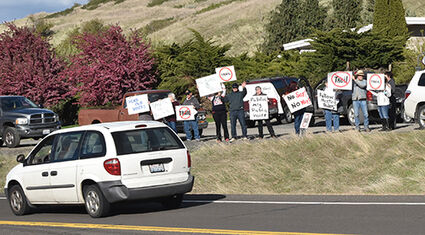
-Chronicle photo
About a dozen critics of the Port of Columbia and the proposed Touchet Valley Trail gathered and peacefully protested while the Port conducted a two-plus hour Zoom webinar, which was attended by about 100 people Monday evening, April 26. Signs indicate members do not feel their input and views are being considered and question the estimated $10.38 million cost of the project.
Another stated concern on the Port website is the perceived danger of having a trail along a working train track and Highway 12. The Port's answer is the train is infrequently used and when in use has a maximum speed of 10 mph. Where the trail runs unusually close to tracks because of space constraints, barriers would be in place. When crossing the tracks, there will be warning signs as with driveway and road crossings. The Port answer to trail along Highway 12 is the purpose of the trail is to keep people off the highway and will not run within the highway right-of-way and will be along the north side of the tracks as much as is feasible.
There are still some lingering questions by landowners and citizens over Port ownership of the land the trail would run on. In addition, there is concern about funding for maintenance since volunteerism cannot be guaranteed, and the 10% of the design.
Some questions and concerns brought to this reporter's attention focused on how the handling of vagrants or illegal camping along the trail, as experienced on other trails around the state is going to be addressed.
Despite objections from the trail opponents, attendees commented that the presentation went smoothly and questions were addressed.
The Port has said it will continue to address questions and post updates on the website as the design comes along.
Those who wish to present a question can submit it on the Port website until May 12, 2021 at https://www.portofcolumbia.org.

